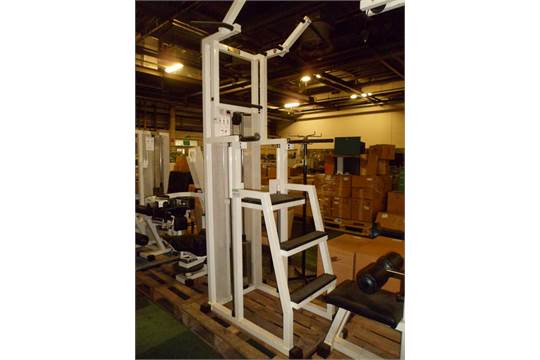Last Sunday morning my trainer had me do some extra exercises. One was a machine I haven't used before. Basically, you sit and you have your legs out in front of you and then you push them away from each other against a weight, afterwards you go to another machine where you do the opposite movement (legs towards each other). This way you exercise your inner thigh muscles. So... for two days I had crazy muscle pain in that area. I don't think they're a muscle group that are often trained using weight. I did a bit of search and here's some interesting info:
I also asked if there is a pull-up bar, and the trainer led me to another machine. This, I have to say, is probably the coolest machine I've tried so far. Basically you set up an amount of weight, then you go up two steps and stand on a small square platform while you hold on to some handles. When you stand on the platform, the platform goes down slowly (or fast if you push harder with your feet), and then you have to pull yourself up (three ways to do so).
I actually was able to do pull-ups, but it's not my weight I'm pulling, though perhaps it is my weight, but the platform works as an assistant... haven't quite figured out how it works yet, but it's great. I've tried to search the webs to find this machine, but it's nowhere to be found! I only get results for 'assisted pull-up machine' and that's not the one. In any case, it was a good workout! FWIW.
“The inner thigh muscles, or adductors, are made up of five different muscles that are responsible for stabilizing the outward rotation of your knee, helping pull the legs toward the center line of your body," explains exercise physiologist Michelle Lovitt, M.A. “These muscles all attach to the pelvis and play a key role in hip flexion and extension. They're also incredibly important in stabilizing your core.” Together, these five muscles—the pectineus, gracilis, adductor longus, adductor brevis, and adductor magnus—function to provide stability and injury prevention for your knees, hips, and low back (to name a few).
[...]
“All five adductor muscles attach to the pelvis, so weak inner thighs [can often lead to] poor core balance,” she says. And having a strong core is key for proper movement in and out of the gym.
Keeping your pelvis supported with strong inner thigh muscles helps prevent injuries, too. “When the inner thighs work with the outer thighs, they provide side-to-side stabilization of the pelvis,” explains Lovitt. “If you have abductors (outer thighs) that are strong and inner thighs that are weak, then you won't have good side-to-side stabilization of the pelvis, and that leads to injuries to other areas of the body, especially the low back.”
I also asked if there is a pull-up bar, and the trainer led me to another machine. This, I have to say, is probably the coolest machine I've tried so far. Basically you set up an amount of weight, then you go up two steps and stand on a small square platform while you hold on to some handles. When you stand on the platform, the platform goes down slowly (or fast if you push harder with your feet), and then you have to pull yourself up (three ways to do so).
I actually was able to do pull-ups, but it's not my weight I'm pulling, though perhaps it is my weight, but the platform works as an assistant... haven't quite figured out how it works yet, but it's great. I've tried to search the webs to find this machine, but it's nowhere to be found! I only get results for 'assisted pull-up machine' and that's not the one. In any case, it was a good workout! FWIW.



